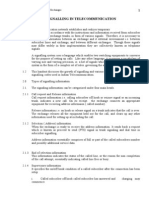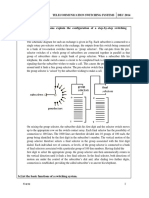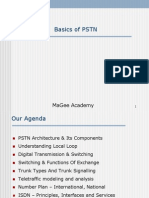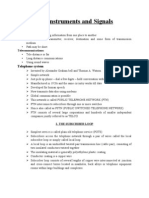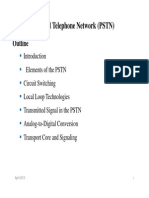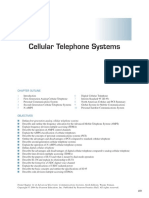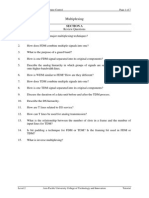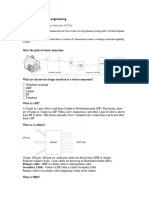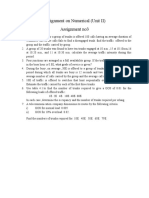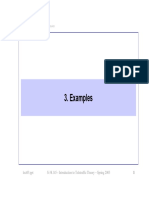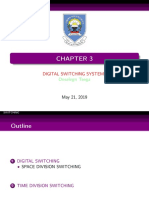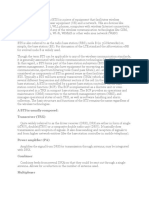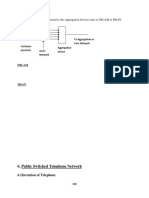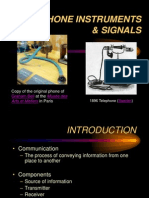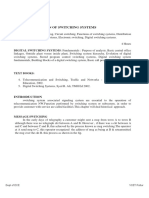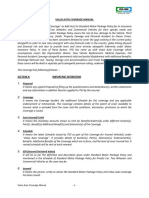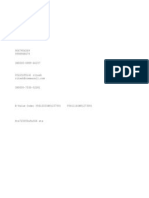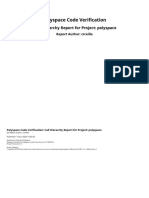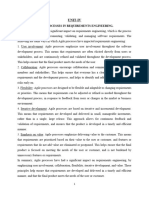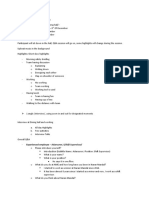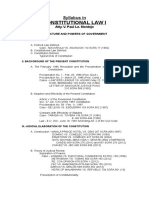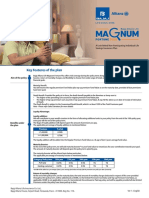BASICS OF TELEPHONY
CLASSIFICATION OF SWITCHING SYSTEMS
Switching systems
Manual System
Automatic
Electro Mechanical
Strowger
Cross bar
Electronic
(Stored program control)
Space Division
Time Division Switch
Digital
Space
switch
Time
switch
Analog
Combination
switch
HISTORY OF TELEPHONY
Page 1
�BASICS OF TELEPHONY
Manual System
1 Conventional system
This telephony system consisted of a simple local battery, simple transmission medium, telephone of handset
for speech, magneto bell for the ring and ringer generator for sending the ring signal. .
Caller
Telephone
Copper medium
called
Signaling method
2wires were used between the phones. Ringer potential was 75V a/c ringer and battery for each
local loop was -48V with line current of 20mA.
Disadvantages
Initial cost was high, system was blocking , maintenance was expensive & disconnection was unpredictable .
SWITCHING TECNOLOGIES
Page 2
�BASICS OF TELEPHONY
Manual System
2. Common Battery
Subscriber set gets energized from a powerful battery at the exchange.Whenever subscriber
goes off hook, switch closes and current flows resulting in a lamp glow up on the Manual board.
The operator then connected manually the caller and gave a connection to the called person.
All offices from the 40s to 60s used this system. These systems are still used in remote areas of rural
India.
SUBCRIBER
LINE
DISTRIBUTION
MANUAL BOARD
MEDIA
SUBSCRIBERS
Signaling method
2wires were used between the phones. Ringer potential used was 75V a/c ringer and battery for each
local loop was -48V with line current of 20mA.
Disadvantage
Major disadvantage was that this system had no secrecy.
SWITCHING TECNOLOGIES
Page 3
�BASICS OF TELEPHONY
Automatic Systems-Electromechanical switches
1. Strowger/ Cross bar Systems
Strowger was the person to introduce the concept of operator less systems. These systems replaced
the conventional manual boards. The system utilized the concept of dial tone to subscriber. The
subscriber would dial digits, which would be interpreted by the system through relays.
Crossbar switches were functionally similar, only the relay size was minimized. It utilized matrix
switching, and hence was faster than Strowger systems. Both these systems replaced all
manual boards during the late 60s.
Strowger/Cross bar systems
Subscribers
Connectivity to other
exchanges.
Subscribers
Signaling method
System utilized dial tone, 75V a/c ring and generators. All telephones had individual -48v battery for
local loop. 2wires were used between the exchange and the phones. Relay mechanism utilized selector
switches or switching matrix for processing the dial digits.
Disadvantages
Systems were bulky in size, consumed high power, were blocking and maintenance was expensive.
SWITCHING TECNOLOGIES
Page 4
�BASICS OF TELEPHONY
Automatic Systems -Electronic Systems (Stored Program Control).
These Electronic Switching Systems utilize a processor for performing the switching functions.
It is a very flexible i.e. new features, facilities can be added within the control program of
the SPC systems. Switching within the SPC has various standards namely SDS and TDS as explained below.
1. Space division switching(SDS)
In SDS a dedicated path is established between calling and called subscriber for the entire duration
of the call. It is the same technique as was used in Strowger and Cross bar.
Stored
Program
Control
Electronic Switching System
Strowger and Cross bar
2. Time Division switching(TDS)
In TDS speech signals are transmitted at fixed intervals i.e. same path is used for a number of connections
on time sharing basis.
Time division switch can be either Analog or Digital.
SWITCHING TECNOLOGIES
Page 5
�BASICS OF TELEPHONY
Analog switching systems
In case of Analog switching sampled voltage levels are transmitted as they are, but
in Digital switching they converted into binary codes (0,1) and then transmitted.
Digital switching systems
In case of Analog switching sampled voltage levels are transmitted as they are, but
in Digital switching they converted into binary codes (0,1) and then transmitted.
1.Digital
Space Switch
If the coded values are transferred during the same interval from input to output,
the technique is called space switching.
2.Time Switching
If the coded values are stored and transferred to the output at later time interval,
this technique is called time switching.
3.Combination Switching
This system utilized a combination of Digital space switch feature as well
as Time switching features.
SWITCHING TECNOLOGIES
Page 6
�BASICS OF TELEPHONY
SWITCHING GENERATIONS
First generation:
Manual switching/electronic switching
Analog switching and transmission
Stored Program Control
Manual board
Second generations
Part of Switching through, digital switching
Analog transmission
Blocking Architecture provided limited data transmission
Third generation/generation 3.5
Fully digital switching/transmission with non-blocking
Strowger/Crossbar Switch
Architecture
Fully digital switch
Voice and data compatibility
Generation 3.5 was same as generation 3, but standard ISDN was
supported,which was also CCS-7 compatible
Fourth generation
Fully digital, distributed Architecture, LAN based
Current generation
Broadband digital switching and transmission through fiber
Definity
Fully integrated voice, data and full motion video
SWITCHING TECNOLOGIES
Page 7
�BASICS OF TELEPHONY
(B.S.N.L / D.O.T / P.T.T)
SWITCH
STD/ISD CALL
LOCAL CALL
VOICE CALL
VOICE CALL
VOICE CALL
LEGEND
STD/ISD MEDIA
: Link by either fiber, Radio, Satellite
LOCAL MEDIA
: Link by copper, D.O.T leased lines, V-sat
or in future W.I.L.L Technology
THE COMPLETE PICTURE
(Voice switching)
Page 8
�BASICS OF SIGNALLING
TELEPHONE SIGNALING
Signaling is required to establish communication between a sender and receiver prior to actual
communication
Following six steps are essential before communication takes place.
Action required by users
Action required at Exchange
Process within Exchange
1. Lift handset
off hook at A
Exchange is about to give dial
tone to subscriber A
Loop Extension at A
2. Subscriber waits for dial tone
as exchange ready signal
Dial Tone (DT) is
send to subscriber A
Dial tone ringer is placed
within the exchange on line
3. user A Dials number of
user B
Dialed number
is processed
by Exchange
Loop Disconnect/Connect
or Tones are received
4. Wait! Communication being
set up by exchange
Ring back tone
(RBT), Busy tone (BT)
or Number unobtainable
tone is send depending on
status of the called number B
Respective tone ringer
are placed online depending
on status.
5.Call attention of called party B
Ring to called subscriber B
Ringer connected
to called party B
6.Lift handset off hook
at subscriber B
Exchange establishes connection
between A and B
Loop Extension at B
SIGNALLING METHOD
Page9
�BASICS OF SIGNALLING
LOOP EXTENSION
Subscriber A
Loop Extension
Switch or Exchange
On lifting telephone (off hook ) current
flows from Switch or Exchange to the telephone
and back. This is called as a Loop extension.
Subscriber B
Legend
Local loop for subscriber A
Generally on a Off hook Dial tone is given to
the subscriber for doing dialing
Local loop for subscriber B
For every telephone connection, 2 loop extensions are
created one at subscriber end A and another at subscriber end B
SIGNALLING METHODS
Page10
�BASICS OF SIGNALLING
Exchanges utilize various tones for communication
Type of tone
Abbreviation used
Usage
Dial tone
DT
when start of any communication is done
Ring Back Tone
RBT
when called party is being rung
Busy Tone
BT
when called person is busy
Number unobtainable tone
NUT
when number dialed is wrong or not
available
Confirmation tone
CFT
when feature is registered by user
SIGNALLING METHODS
Page11
�BASICS OF SIGNALLING
Dialing methods
Dialing is a signaling mechanisum to transmit telephone numbers to the local exchange. Dialing methods generally used are
Pulse dialing or Tone dialing.
Pulse dialing
Current
Loop extension between the user instrument and local exchange is broken and made for certain duration. This duration of make
and breaks are fixed. Local exchange is intelligent to understand the number dialed. Speed of dialing is calculated in PPS
(Pulse Per Seconds). Tp
Time
Loop
Open
Loop
Break
Closed
Make
Inter digit pause (IDP)
Duration of Make ration = 33 m secs
Duration of Break ration = 67 m secs
Tp= 100 m secs (time period for one pulse)
IDP =inter digit pause (600-700 m secs) (This is used between two digits)
Speed of dialing = No. of digits (Max.) 10 digits X 100%
Tp (100 m secs)
( In case Tp = 50 m secs then speed of dial is 20 pps)
= 10 pps.
SIGNALLING METHOD
Page12
�BASICS OF SIGNALLING
Tone dialing/Touch Tone/DTMF Dialing
Tone dialing uses a dual tone matrix to generate unique frequencies for each dial digit.
DTMF ( dual tone multi frequency) utilized unique frequencies for each digit. Tone dialing is faster.
Each digit needs 64 m sec only.
Advantages of Tone dialing
Wrong dialing can never occur in DTMF dialing.
Today DTMF signaling is utilized in variety of features other than dialing e.g. Voice Mail , I.V.R (Interactive Voice Response),
alpha numeric dialing for data applications.
COMPARISON BETWEEN A DIAL PULSE AND TONE DIALING
Duration required to dial digit 022 4930492 can be calculated as follows
In pulse dialing, digit 0 needs 10 pulses. Each pulse is 100 m sec duration. 9 pauses would be required for dialing
digit 0. Hence total time to dial digits will be as follows
n= total no. of digits in the number 022 4930492 would be 55 digits ( 10+2+2+4+9+3+10+4+9+2)
A= 55 X 100m sec = 5500 m sec ( duration required to dial 022 4930492 )
B= 9 x 700 m sec =6300 m sec (9 inter digit pauses would be required for a 10 digit number )
Total time required to signal to exchange in a Dial pulse mode would be = A+B= 11855 m sec = 11.8 sec
Total time required to signal to exchange in DTMF mode would be 64m sec X 10 = 640 milliseconds
SIGNALLING METHOD
Page13
�BASICS OF SIGNALLING
Frequencies utilized for DTMF dialing
Following frequencies are used for DTMF dialing
1209 Hz
1336 Hz 1477 Hz 1633 Hz
2
ABC
GHI
JKL
7
PQRS
8
TUV
3
DEF
6
MNO
Higher level frequency
697 Hz
S
p
a
r
e
770 Hz
852 Hz
Lower level frequency
WXYZ
941 Hz
OPER
Totally 16 tones are available today only 12 are used. Rest are spare not utilized.
*, # can be programmed on local switch as additional features.
Each digit is marked with alphabets which are used for name dialing or alpha numeric dialing.
All frequencies are in speech band, hence telephone handset requires a feature called as flash for interupting
the speech path for functions like transfer or conference.
SIGNALLING METHOD
Page14
�BASICS OF SIGNALLING
Signaling types:
(RD) Ring down signaling
(LD) Loop disconnect
(OD)/(E&M) Out of dial/ Ear and mouth
(E-1,T-1) 2MB/1.54MB
(ISDN)-Bri/Pri
SIGNALLING METHOD
Page15
�BASICS OF SIGNALLING
Ring down signaling
This signaling is used between the following
areas as mentioned
A) Between Telephone and Switch
B) Between Switch and local exchange (D.O.T)
C) Between D.O.T to its subscriber
Picture a case where Subscriber A of
Definity switch is in communication with Subscriber B of
the Local (D.O.T) switch.
Six steps of communication remain same as mentioned in the
earlier (Slide # 11) called as Ring Down signaling.
Ring is always send from the switch
to the telephone. Hence it is called Ring Down signaling.
Pulse or tones are always sent from telephone to Switch
Switch
Pulse or
Tone
DOT/BSNL/PPT
Pulse or
Tone
Pulse or
Tone
Ring
Ring
Ring
Ring Down
Signaling
Signaling characteristics of Ring Down signaling.
2 wires between telephone and switch
-48 V as battery feed
75 V a/c for ring generation on telephone
20 mA current loop between telephone and switch
1200 ohms Loop resistance between phone and switch
120 ohms instrument resistance
Pulse dia1ing at 10/20 pps or DTMF/Touch Tone dialing
Legend:
Line interface
CO Trunk interface
Pulse/tone direction
Ring direction
SIGNALLING METHOD
Page16
�BASICS OF SIGNALLING
Loop Disconnect (LD) Signaling
Loop Disconnect
Signaling
This signaling is used between two switches.
(e.g between two Definity switches)where
distance are up to around 4-5 kms.
Switch- A
Pulse or
Tone
Between Switches only Pulses or DTMF tones
are exchanged. Ring is not utilized
All characteristics are same as RD Signaling.
Accept that Ring is not used
Signaling characteristics
2 wires between telephone and switch
-48 V as battery feed
20 mA current loop between telephone and switch
1200 ohms Loop resistance between phone and switch
120 ohms instrument resistance
Pulse dia1ing at 10/20 pps or DTMF/Touch Tone dialing
Telephones A,B are rung individually by respective Switch A
or B.
Ring
Switch- B
Pulse or
Tone
Pulse or
Tone
B
Ring
Ring Down
Signaling
Legend:
Line interface
LD Trunk interface
SIGNALLING METHOD
Page17
�BASICS OF SIGNALLING
Out of Disconnect (OD) Signaling
This signaling is used between two switches. All
signals are above the voice band, hence this
signaling is called OD signaling.
This signaling is used when switches are linked
via leased lines which involves large distances
(e.g. v-sat, Microwave or DOT leased lines)
Between Switches either Pulses or DTMF tones are exchanged.
Ring is not utilized
A
OD Signaling
Pulse or
Tone
Ring
Signaling characteristics
All characteristics are same as LD Signaling.
Signaling is done on the Signaling leads SS, SR
and speech signal is on LA,LB leads.
4, 6 wires are used between 2 switches.
-48 V as battery feed is on Signal send Lead (SS) and Signal Receive (SR)
Pulse dia1ing at 10/20 pps is done between SS and Signal ground
In case of Tone dialing Tones are sent on Speech limbs.
Telephones A, B are rung individually by respective Switch A
or B.
Switch- A
Switch- B
Pulse or
Tone
Pulse or
Tone
B
Ring
Ring Down
Signaling
Legend:
Line interface
E&M Trunk interface
SIGNALLING METHOD
Page18
Page1
�BASICS OF SIGNALLING
Signaling Detail :
OD Signaling
SS lead is used to pulse digits w.r.t to
signal ground.
SR lead is used to receive earth when
call party acknowledge
Pulse or
Tone
2 methods are used for signaling
4W E&M 2wires for Speech (LA,LB)
2 wires for Signaling (SS,SR)
6W E&M 2wires for Transmit Speech (TA,TB)
2wires for Receive Speech (LA,LB)
2 wires for Signaling (SS,SR)
Switch- A
Switch- B
.
Ring
These Signaling and Speech limbs are carried on a carrier
either through leased lines or Radio.
Connection Method:
SS sends digits w.r.t to earth to SR of Exchange B
On receipt of all digits Exchange B sends Earth on it SS limb
This Earth of SS limb is received on SR limb of Exchange A
Once this connection is complete speech takes place on LA,LB
SS
SR
LA
LB
SG
Pulse or
Tone
SS
SR
Ring
SG
Ring Down
Signaling
Legend:
Line interface
E&M Trunk interface
SIGNALLING METHOD
Page19
�BASICS OF SIGNALLING
PCM (Pulse code modulation)
Current Technologies utilize PCM technology. Each line/ trunk port is subjected to PCM. This converts speech signal
into 8 bit(0/1) format through a codec (Coder, decoder).
Conversion of Analog speech to a digital bit stream is as follows.
PCM building blocks
Speech signal between 300Hz and 4KHz are only taken for processing. These frequencies are selected as they carry
relevant speech information.Following blocks are used for PCM.
Analog
Speech
Low
Pass
Filter
Sampling
Quantizer
Coder
Digital
signal
1.LPF (Low Pass Filter)
Analog speech signal is passed through LPF for selection of frequencies between 300Hz and 4KHz.
2.Sampling
Maximum frequency for Sampling is 4Khz.
F max=4Khz
Fs= 2 X F max ( as per Niquist law Sampling frequency is twice F max)
Ts= 1 / Fs ( Ts =time period required for sampling)
Ts= 1 / 8 kHz = 125 u sec.
PCM/TDM TECHNOLOGY
Page20
�BASICS OF SIGNALLING
2.Sampling (contd)
Analog signal from a line/trunk port is sampled
at finite duration of 125 u sec (Ts sampling frequency).
3. Quantization
Naturally sampled signal is then subjected to quantization
and companding which use either A law or u law, to
quantify the sampled pulse into digitized format.
Analog speech signal
M(t)
T
Sampling Signal with pulses
of finite duration
S(t)
Each sample is expressed 8 bit. Hence 28 combinations
are possible ie 256 values. Each sample is assigned one
of these 256 values.
4. Coder
Output of codec is always in 8 bits, serially on time
basis as shown in the figure.
These samples from each port are placed in a time
slot inter (TSI) changer for switching. These 8bit
information can be transported faster and easily.
Ts=125u sec (sample every 125u sec)
Naturally sampled signal
S(t) X M(t)
Codec
Output
T
Digitized voice sample after
quantization/companding
01010000
To
01011111
T1
PCM/TDM TECHNOLOGY
Page21
�BASICS OF SIGNALLING
32 Channel PCM signaling
One channel corresponds to one analog path (either transmit of receive) which is basically 8 bits
Speed of this channel is 8bits at 8 kHz = 64 KBPS.
In all PCM TDM exchanges 32 such channels are clubbed together to make one transmit/receive
high way.
Fig shows bit stream of a 2MB highway
Channel 0
Channel 1
Channel 2
0 1 1 0
Channel 3
...
Channel 31
1 0 1
Bit rate of such a highway is 64 x 32 KBps = 2.048 Mbps
Several highways are then switched within the system with the help of (TSI) Time Slot Inter changer.
PCM/TDM TECHNOLOGY
Page22
�BASICS OF SIGNALLING
TDM (Time Division Multiplexing)
Multiplexing is a technique whereby a number of independent signals can be combined into a
composite signal suitable for transmission over a common channel.
Block diagram of a TDM system.
Synchronized Clock
1
Low
Pass
Filter
Low
Pass
Filter
Pulse
Modulator
Commutator
Transmission
Channel
Pulse
Demodulator
Decommutator
Low
Pass
Filter
Low
Pass
Filter
Voice inputs are passed through LPF (low pass filter)
Commutator selects value of each voice sample from 1 to n at time period of 125 u sec
Pulse modulator/demodulator converts analog signal to digital pulses and vice versa
Transmission channel is switching module commonly known Time slot inter changer
Commutator and Decommutator are samplers running in synchronized fashion
PCM/TDM TECHNOLOGY
Page23
�BASICS OF SIGNALLING
Time Slot Inter changer ( TSI)
Time slot inter changer inter changes digital speech values on time basis.
Block diagram of a TS I. For 256 x 256 channel
Read highway
Digital
signals
from each
codec
a
b
CH 0
(SPM)
Speech path memory
CH 0
CH1
CH1
CH 15
CH 15
CH 255
CH 255
Send highway
b
CH 0
CH1
CH 15
Interchanged
Digital
signals
to each
codec
CH 255
Hold memory
Read highway and Send highway are parallel
buses containing digital speech
All information from read highway is serially
transmitted to SPM
Hold memory contains address where channel
needs to be switched.
Depending on Hold memory address the SPM
writes randomly into Send highway
15
CH 0
CH1
CH 15
CH 255
PCM/TDM TECHNOLOGY
Page24
Page2
�THE COMPLETE
PICTURE
BASICS
OF SIGNALLING
ISD
PBX
STD
Last mile
on copper
DOT
NETWORK
N
ISD
Local
Exch.
y
ivit
ect
n
con
Cellular
Network
Voice
Data
Video
Fax
Paging
Network
Vsat connectivity
Legend:
Copper Media
Copper, fiber, Radio(Media)
Fiber, Radio, Sattelite (Media)
Fiber, Radio,V-sat, Sattelite
(Media)
G.S.M switching
Page 25
�BASICS OF TELEPHONY
SWITCH
(B.S.N.L / D.O.T / P.T.T)
(MSC)
VOICE CALL
.
BSC
BSC
BTS
MOBILE
SWITCHING
EQUIPMENT
CELLULAR
Sub..
BTS
LEGEND
LOCAL MEDIA
Mobile
office
communication
: Link by copper, Fiber, leased lines
or in future WILLS Technology.
CELLULAR MEDIA : Link by either GSM,,
( DECT/ CT-2/ pHs for mobile office communication)
BSC
: BSC (Base station controller), BTS (Base terminal controller)
THE COMPLETE PICTURE
(Cellular switching)
Page 26
�BASICS OF TELEPHONY
The basic principles of Cellular systems were established by Bell laboratories in 1949 but was
not until the early 1980 that technology allowed real commercial networks to built and service
offered to the public
Systems were developed at different times in different countries and subjected to a variety of
different constraints such as frequency, channel spacing, etc.
Different incompatible cellular standard emerged throughout the world
One such notable system is GSM (Global Systems for Mobile communication)
Cellular network configuration:
(MSC)
BSC
BTS
MOBILE
SWITCHING
EQUIPMENT
(M.T.N.L / D.O.T / P.T.T)
CELLULAR
Sub..
Network management
INTRODUCTION
(Cellular switching)
Page 27
�BASICS OF TELEPHONY
Principles of Operation:
In the cellular radio system, the area to be covered is divided up into a no. of small areas called
cells, with one radio base station (BTS) positioned to give radio coverage to one cell.
Each base station is connected by a fixed link to a mobile services switching center (MSC), which
is linked to a digital telephone exchange with special software to handle the mobility aspects of its
users.
Most cellular networks consists of a number of MSCs each with their own BSs, and interconnections by
means of fixed links.
The MSCs interconnection to the (PSTN) for both outgoing and incoming calls
A cellular network will be allocated a no. of radio frequencies, or channels, for use across its coverage
area,this no. being dependent upon the amount of spectrum made available by the licensing authority
and the channel spacing of the technical standard used by the network
The radio channels are grouped together into a no. of channel sets, and these sets are then allocated
to the cells. Each channel will be re used many times by the network.
Radio planning is essential for every cellular network operator to build these cells. The planning includes
aspects like cell repeat pattern, Co-channel interface, radio propagation, coverage area, cell capacity,
no of channels requirement , density of calls in each area etc...
NETWORK CONFIGURATION
(Cellular switching)
Page 28
�BASICS OF TELEPHONY
(B.S.N.L / D.O.T / P.T.T)
SWITCH
VOICE CALL
SWITCH
PAGING EQUIPMENT
BS
VOICE CALL
Paging service operator
Subscriber
Pager
LEGEND
LOCAL MEDIA
: Link by copper, Fiber, leased lines
or in future WILLS Technology.
PAGER MEDIA
: Link by either POCSAG/FLEX/APOC
Modem
communication
: Communication via TAP protocol
bulk paging
THE COMPLETE PICTURE
(Pager switching)
Page29
�BASICS OF TELEPHONY
PAGING TECHNOLOGIES
In 1970 Bell Canada introduced its wide area digital paging systems, which utilized digital formats, greater system
address capacities, much greater battery economy, faster call rates, pager size reduction, additional storage of calls
and messages in memory.
Subsequently Sweden inaugurated its national paging service using a sub carrier on the national broadcast system in
the same year
North America systems supplied systems based on the Golay code format.
Japan had already opened the NTT digital systems in 1978 .
In 1978 UK agreed a common digital paging systems, POCSAG (Post Office Code Standard Advisory Group) with
recommendation from 16 major pager manufactures.
Todays new generation of high speed digital code formats have been formulated e.g. FLEX developed by Motorola
Inc. and APOC developed by Philips Telecom.
POCSAG at 2400bits/sec can provide 32k users per channel
ERMES at 6250 bits/sec can provide 145k users per channel
FLEX at 64kps can provide up to 157k per users per channel
APOC with PAM/FM modulation tech. At 64kps provide up to 395k users per channel
All these capabilities are for 40 characters alphanumeric messages.
TELECOM
(Pager switching)
Page 30
�BASICS OF TELEPHONY
Principles of Operation:
Paging is a one way radio alerting system.
The direction of transmission is from a fixed transmitter to an individual. It is a simple extension of the PSTN network
The paging receiver is simple box, which alerts the the user in the event of message sent to him
Some pagers have a digital readout others only have calling number display.
These paging systems operate on the VHF or UHF bands with 3-khz band width.
Transmitter have 1 to 5 watts of output and pager receivers have sensitivity of 10 to 100 micro volts
Radio frequency bands for pagers are typically 26.1-50 MHz, 68-88 MHz, 146-174 MHz, 450-470 MHz or 806- 960 MHz
To cover a service area effectively no. of radio paging transmitters are utilized. These transmitters operate either
sequentially or simultaneously.
POCSAG Systems are designed to share a channel with codes for simultaneous and sequential transmission multi transmitter
operation at the normal transmission speed of 512 bps. The code format can handle over 8 million addresses and can be
expanded.
Bulk paging can also be done with the help of modem connectivity through interactive IVR using TAP protocol. These are
generally used by courier coy. , banks for delivery systems and transactions.
(Pager switching)
Page 31
�BASICS OF SIGNALLING
Switch
SwitchA
Up link
V-sat
hub
Switch- B
Down link
E&M
or
2MB interface
LEGEND
LOCAL MEDIA
: Link by copper, Fiber, leased lines
or in future WILLS Technology.
V-SAT MEDIA
: Link via Sattelite using DMA or
TDMA Technology.
THE COMPLETE PICTURE
(V-sat switching)
Page32
�BASICS OF TELEPHONY
Principles of Operation:
Very Small Aperture Terminal (V-SAT) are defined by their antenna aperture (diameter)
which can vary from (0.5)mts to (2)mts.
There are three underlying reasons for the use of V-SAT networks
1. Economically alternative to establish data network, particularly if traffic is to/from
central facility, usually a corporate head quarter to/from outlying remotes.
2. To by pass telephone companies or leased lines
3. To provide quality of service through better telecommunication connectivity where
other means are substandard or non existent
Figure shows the hub/V-SAT concept of a star network with
the hub at center.
HUB
In V-SAT low delay, simplicity of implementation and robust
operation are generally of greater importance than the bandwidth
efficiency
V-SAT
(V-sat switching)
Page 33
�BASICS OF TELEPHONY
Message access on any shared system can be of three types
1. Fixed assigned:In Fixed assigned multiple access, V-SAT protocols are FDMA, CDMA and TDMA.
All three are comparatively inefficient in the bursty environment with hundreds of potential users.
2. Random access:In this method called (SERJ) selective reject, stations transmit new messages on the channel as
they are generated . Collision resolution is achieved simply by transmitting colliding packets randomly with delay.
This method has low efficiency low access delay, the ability to handle variable length packets, robust operation and
minimal equipment complexity.
3. Controlled access: This method is based on Demand assignment multiple access (DAMA) schemes and are useful in
variable data frames. DAMA can be explained as a two step process.
In phase I short reservation packets are transmitted from the V-SAT requesting service and giving information regarding
the stations demand.
The phase II is actual passing of data.
Generally DAMA with TDMA type access with slotted access provides overall good performance and can handle
mixed interactive traffic.
(V-sat switching)
Page34
�BASICS OF TELEPHONY
V-SAT Transponder Operation:
Total V-SAT system may occupy no more than 1 MHz of transponder space. Larger V-SAT may require more transponder
bandwidth. Typical V-SAT system operation with a 1-MHz allocation on a satellite transponder.
HUB
TDMA carries 9.6 kbps each
TDM 56 kbps
1- MHz
TDMA inbound carriers to the hub can be configured for one
user per channel or multiple user per carrier using one of several
TDMA access techniques.
There are sub networking possibilities as well, for example
TDMA carrier may be assigned to a family of users.
(V-sat switching)
Page 35




